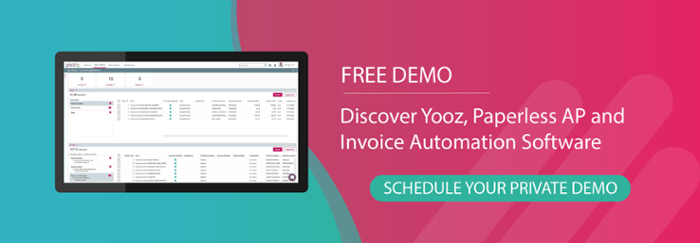Growth is always welcome news for companies. It represents both the goal and the reward for months of effort. However, for accounting departments, growth presents its own set of challenges: Increased activity often leads to a higher volume of invoices, quickly pushing the organisation’s capacity to its limits.
Of course, hiring an additional person to handle this increased workload is an option, but companies are often reluctant to adopt this costly solution, recognising that it’s merely a temporary fix.
When faced with business expansion, the question is not always about having more people, but about being efficient with the people you already have and then integrating new hires if needed once the processes are optimised and efficient. To do this, adopting AP automation software is essential for finance and accounting departments.
This article highlights the top ten key factors to consider when selecting the right software.
What is Accounts Payable automation?
Accounts Payable (AP) automation refers to the digitalisation and streamlining of the AP process through the use of advanced software.
Traditionally, Accounts Payable departments relied heavily on manual data entry and paper invoices. This reliance often resulted in human errors, duplicate payments and limited financial visibility.
AP automation helps finance teams save time by automatically processing invoices, integrating invoice data with accounting software and expediting payment preparation. It streamlines invoice management thanks to features like centralised invoice capture, 2-way and 3-way matching, and approval workflows. The implementation of these features corresponds with AP automation best practices, which will be discussed in more detail later in the article.
An AI-powered AP automation solution enhances data accuracy, delivers cost savings and eliminates time-consuming manual tasks. This efficiency enables finance teams to focus on higher-value activities like financial analysis and supplier relationship management, boosting overall productivity.
The accounting department and the growth challenge
Before hitting a growth wall, many companies manage their accounting in a traditional way. This involves manually entering invoices one by one, validating them and transmitting payment records. It can take weeks to process an invoice and as volume increases, so do these timelines.
This also results in an increase in duplicated documents, disputes and an ever-growing mountain of paperwork. Consequently, accountants spend a lot of time dealing with payment delays and penalties, which are neither fulfilling for them nor productive for the business.

Digitalisation and automation: The solution to streamline processes
To ensure growth benefits are not lost in administrative inefficiencies, the solution is to streamline accounting processes through digitalisation and automation.
Digitalising and automating AP processes does not simply mean digitising documents. Doing so would merely replace paper complexity with digital complexity, offering only marginal benefits.
Instead, invoice digitalisation and AP automation primarily enable the automation of successive process steps, from procurement management to invoice processing, including scanning, automatic recognition, recording, allocation, electronic validation workflows and exporting data to ERP or accounting software.
Stakeholders are kept informed of the progress and can validate key stages based on predefined rules (invoice type, amount, etc.), ensuring accuracy.
Modern AP automation solutions, based on Artificial Intelligence, can handle all types of documents without pre-sorting, regardless of format, medium, or presentation (email, PDF, EDI, etc.).
As for the documents themselves, a search engine allows them to be easily found and reviewed.
Significant productivity gains
Thanks to intelligent automation, companies can benefit from substantial time savings. Processing cycles are significantly shortened, leading to faster and more efficient invoice handling.
Additionally, quicker processing of supplier invoices reduces delays, disputes and time spent answering supplier queries, resulting in further productivity gains.
Equipped with this solution, accounting departments become significantly more efficient, allowing them to handle growing activity without requiring additional staff.
Now, it’s time to choose the best solution to meet your needs, guided by the following three prerequisites.
Up first is understanding the costs and processing times associated with invoice management, as this baseline will help calculate the solution’s ROI.
This step is essential, as it will reveal that potential savings are much higher than initially expected without a comprehensive audit. Intuition should give way to deduction and reasoning should replace assumption!
All stakeholders reap the benefits: senior management, having made a wise investment to improve organisational efficiency and productivity; the finance department, seeing both immediate progress after implementation and a significant ROI in the long-term; and users, who adopt an agile solution that saves time by eliminating repetitive tasks.
The second prerequisite is to understand the entire invoice validation workflow. The complexity and interdependence of workflows determine the choice of AP automation solution.
The third prerequisite involves anticipating invoice volumes, which will also guide the choice of solution and its architecture.

The 10 best practices
Once these fundamentals are established and goals are clear and shared with all stakeholders, several criteria should be prioritised when selecting the right solution.
Here are ten factors to keep in mind:
-
Ease of integration with accounting software, ERP and CRM: Seamless integration with existing accounting software, ERP and CRM systems is crucial for smooth data flow and operational efficiency.
-
Automation of invoice entry and validation processes, with omnichannel capture (email, mobile, supplier portal, post) of all types of documents (invoices, purchase orders, delivery notes), regardless of format (paper, PDF): the solution should cover all processes and workflows to maximise performance.
-
End-to-end traceability and secure archiving of operations: The solution must offer user authentication mechanisms, secure electronic classification/archiving and robust environments for clients, such as ISO27001.
-
Ability to use the solution on the go: Mobile accessibility ensures users can manage AP processes anytime, anywhere.
-
Real-time data and dashboards, to ensure visibility and control, anticipate fluctuations in invoice volumes and make confident decisions.
-
Compliance with current and future regulations: The solution must guarantee compliance, particularly to accommodate frequent changes in the finance and accounting sector.
-
SaaS/cloud-based usage: Compared to on-premise operations, SaaS minimises costs, enhances agility and adapts to usage and volume needs. Testing and deployment phases, traditionally lengthy with internally managed solutions, are kept to a minimum with SaaS, as the operating environment is already functional. Once set up, the solution is immediately available on any internet-connected device, saving valuable time for IT teams, allowing them to focus on other value-added projects.
-
Proven track record with a significant client base: The provider should demonstrate a solid client base with testimonials on the solution's benefits.
-
Automatic anomaly detection, such as identifying unusual amounts or forged documents.
-
High-quality support and guidance from the provider, with accessible hotlines (including chat support) and help with configuration and user training.
This information equips you to make an informed decision and select the software best suited to your organisation’s needs.
Choosing the right AP automation software is crucial for long-term efficiency and scalability. Here are some FAQs about our software to help you learn more about its features!
FAQ Yooz
Does Yooz offer seamless integration and flexibility?
Does Yooz have comprehensive automation features?
Does Yooz provide enhanced security and compliance?
Does Yooz enable mobility and accessibility from everywhere?
Does you offer user-friendly dashboards and analytics?
Does you offer scalability to support business growth?
Has Yooz a proven reliability and client satisfaction?
Does Yooz offer intelligent anomaly detection and fraud prevention?
How does Yooz customer support and training look like?
With Yooz, finance teams experience a dramatic reduction in manual tasks, an improvement in process accuracy and significant cost savings. Yooz allows companies to optimise their AP workflows and improve supplier relationships by accelerating payments and providing greater financial visibility. By adopting Yooz, companies take a strategic step toward enhancing productivity, compliance and agility and gain clear competitive advantages.
Want to discuss your business’s specific needs and see how Yooz works?








